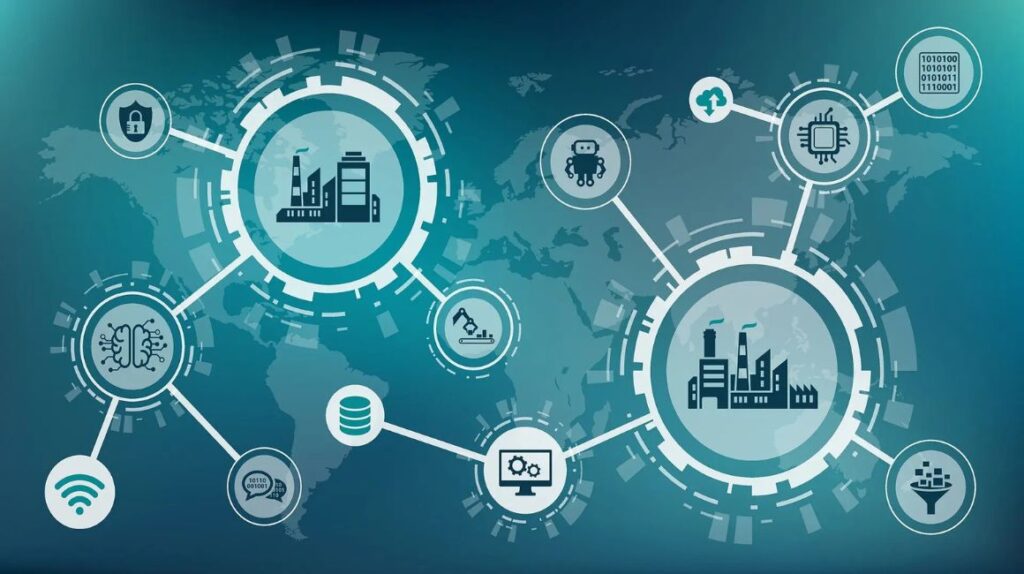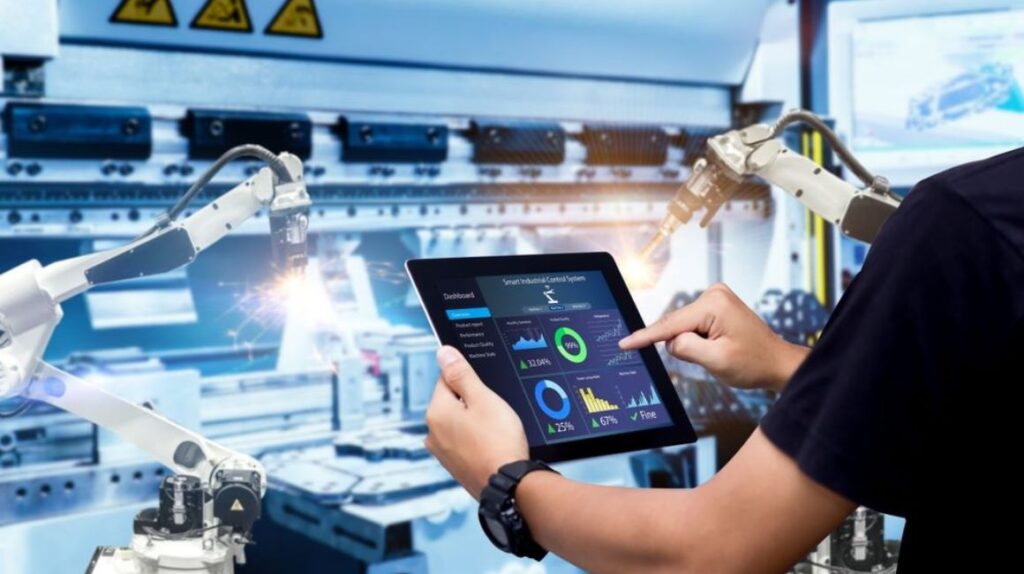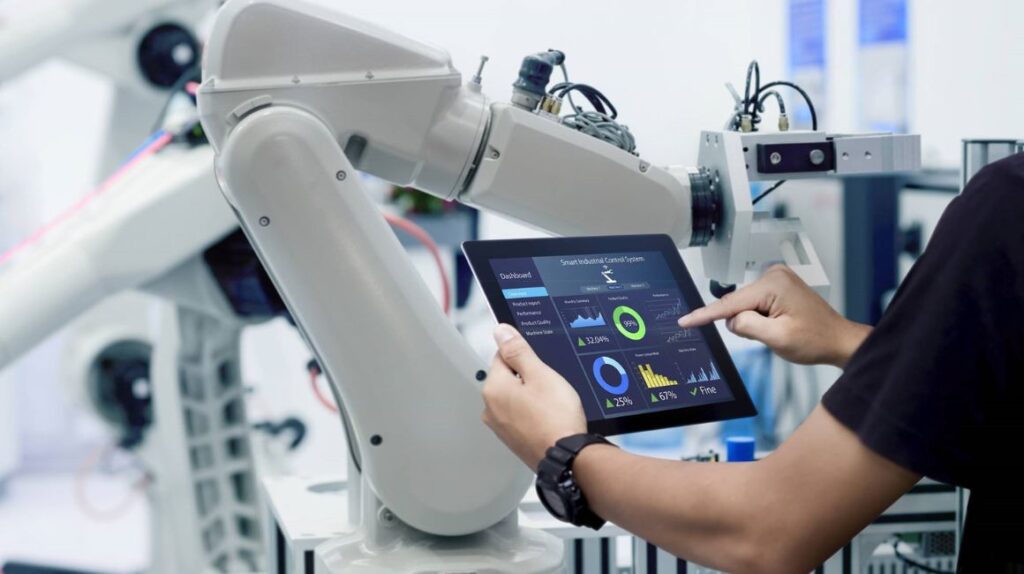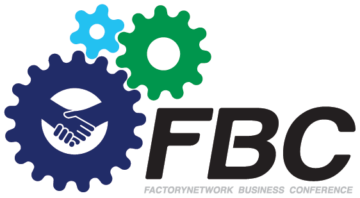Mục lục
ToggleThe race toward smarter, more connected factories is accelerating and industrial IoT applications are at the heart of this transformation. With rising demands for productivity, predictive maintenance, and agile production, manufacturers are turning to IoT solutions to bridge the gap between physical operations and digital intelligence. In this article, FBC presents a smart factory blueprint, spotlighting the most impactful industrial IoT applications for 2025.
What is the industrial internet of things (IIoT)?
The Industrial Internet of Things represents a sophisticated ecosystem of interconnected devices, sensors, and systems that collect, analyze, and act upon operational data to optimize manufacturing processes, enhance safety, and drive continuous improvement throughout industrial operations.
Key benefits of industrial IoT applications
Industrial IoT implementation delivers transformational advantages across manufacturing operations through intelligent connectivity that optimizes performance, reduces costs, and enhances safety while providing strategic capabilities for competitive differentiation.
Improved operational efficiency and productivity
IIoT systems boost manufacturing efficiency by enabling real‑time monitoring, intelligent automation, and data‑driven optimization. Continuous equipment tracking with predictive analytics prevents performance loss and can raise OEE by 15–25%, while real‑time process adjustments maintain peak output under varying conditions. Intelligent coordination of machines, materials, and staff improves resource utilization by 20–30%, and smart energy management cuts consumption by 15–25% without sacrificing production targets.
Real-time decision-making with data insights
IIoT platforms deliver real‑time data and analytics that enable rapid, responsive decision‑making in manufacturing. Live dashboards give managers visibility into production, equipment health, and quality, while predictive analytics forecast failures, quality issues, and bottlenecks with recommended preventive actions. Machine learning drives data‑based optimization to boost performance and reduce costs, and comprehensive analytics support long‑term planning that aligns operations with business goals and market demands.
Enhanced safety, compliance, and worker well-being
IIoT systems enhance workplace safety by continuously monitoring environmental conditions, equipment status, and worker activities, issuing instant alerts and automated responses to hazards. Air quality, temperature, noise, and chemical levels are tracked in real time, preventing up to 80–90% of incidents through early intervention. Equipment monitoring with predictive maintenance averts safety risks, while wearables and smart sensors track worker location, vitals, and hazard exposure for rapid assistance.
Reduced downtime and predictive maintenance capabilities
IIoT enabled predictive maintenance shifts from reactive or fixed schedules to condition‑based strategies that prevent failures and cut costs. Continuous monitoring with machine learning can predict issues 2–8 weeks in advance with over 85% accuracy, allowing maintenance during planned downtime. This approach reduces maintenance expenses by 20–30%, lowers spare parts inventory by 15–25% while ensuring availability, and cuts unplanned downtime by 30–50%, boosting reliability and production consistency.
Better asset tracking and inventory management
IIoT systems enhance asset tracking and inventory management by providing real‑time visibility into location, condition, and utilization through RFID, GPS, and sensor networks. Predictive analytics and automated reordering optimize stock levels, cutting inventory costs by 20–30% while improving availability. Integration with supplier systems enables end‑to‑end supply chain visibility, reducing lead times and improving delivery performance. Detailed utilization data maximizes asset value and identifies opportunities to boost efficiency and capacity.

Top applications of IoT in industrial automation
Industrial IoT applications span diverse operational areas where intelligent connectivity and data analytics create measurable improvements in efficiency, quality, safety, and cost management across manufacturing operations.
Smart factory and connected machines
Smart factories use full IIoT integration to link machines, systems, and processes into an intelligent, self‑optimizing environment. Connected machine networks coordinate equipment in real time, boosting efficiency by 20–30% through optimized scheduling and process control. Integrated production lines adapt to changing needs while maintaining quality, and digital manufacturing platforms give complete visibility with predictive analytics. Autonomous capabilities allow systems to adjust and optimize performance without human intervention under normal operations.
Predictive maintenance and condition monitoring
Condition monitoring uses sensors to track equipment performance and detect early signs of failure, enabling predictive maintenance that avoids unplanned downtime. Vibration analysis reveals wear, imbalance, and alignment issues, while temperature monitoring flags overheating and cooling failures. Oil analysis detects contamination and wear particles to predict component issues. By combining sensor data, performance analytics and machine learning determine optimal maintenance timing and pinpoint root causes of degradation.
Real-time quality assurance
IIoT‑enabled quality assurance continuously monitors production, detects deviations instantly, and applies automatic corrections to maintain standards. Inline inspection with machine vision, sensors, and AI identifies defects in real time, while integrated process control adjusts parameters to uphold specifications despite variable conditions. Enhanced statistical process control and predictive quality models use live data to forecast outcomes, enabling proactive defect prevention before products are completed.
Automated inventory and asset tracking
RFID and sensor‑based systems enable real‑time tracking of inventory, assets, and material flow, streamlining manufacturing operations. They monitor raw materials, work‑in‑process, and finished goods to identify bottlenecks and efficiency gains, while tool tracking optimizes usage and maintenance. Asset management platforms oversee equipment and vehicles to maximize utilization and reduce costs. Automated replenishment uses consumption data to trigger purchase orders and coordinate deliveries, ensuring optimal stock levels.

Energy usage optimization and environmental monitoring
Energy management systems optimize manufacturing power use by tracking consumption in real time, identifying inefficiencies, and reducing costs through intelligent load and equipment control. Demand response integration helps facilities lower expenses and support grid stability. Environmental monitoring tracks emissions, waste, and resource use, ensuring regulatory compliance and sustainability reporting. Carbon footprint analysis pinpoints greenhouse gas reduction opportunities, supporting corporate environmental goals with data driven strategies.
Worker safety through wearables and smart sensors
Wearables and smart sensors enhance worker safety by tracking location, vital signs, and hazard exposure, issuing instant alerts in dangerous situations. Devices detect incidents like falls, confined space entry, and hazardous condition exposure, while environmental sensors monitor air quality, gas levels, noise, and radiation. Emergency response systems relay incident details and locations for rapid assistance, and safety analytics use incident and near‑miss data to guide preventive measures and improve overall safety performance.
Robotics and autonomous guided vehicles (AGVs)
Intelligent robotics and AGVs use IIoT connectivity to streamline material handling, assembly, and logistics while adapting automatically to production changes. Fleet management systems optimize AGV routing, scheduling, and charging for maximum efficiency, while collaborative robots safely share tasks with human workers. Real‑time feedback and machine learning enhance robotic performance, and autonomous navigation allows safe operation in dynamic environments, avoiding obstacles and coordinating with equipment and personnel.
Remote operations and machine control
Remote operations and machine control use IIoT integration to run manufacturing equipment from centralized or off‑site locations while ensuring safety and performance. Remote diagnostics let experts troubleshoot and guide repairs worldwide, cutting downtime and travel costs. Virtual operation centers oversee multiple facilities for coordinated, optimized performance, while augmented reality tools provide real‑time maintenance support. Cloud‑based control systems enable secure remote access with strong authentication and encryption for operational continuity.
AI-enabled industrial IoT applications
AI‑enabled IIoT transforms manufacturing through autonomous optimization, predictive analytics, and advanced data insights. Digital twins create real‑time virtual replicas of assets for simulation, what‑if analysis, and virtual commissioning, helping identify issues and optimize performance before physical changes. Edge AI processes sensor data on the factory floor for instant anomaly detection, predictive maintenance, and autonomous process control without cloud latency.
AI‑driven quality control uses computer vision and pattern recognition to detect defects, predict quality outcomes, and automate rejections with high accuracy. Worker safety is enhanced through AI monitoring of behavior, environment, and hazards, enabling proactive prevention and optimized emergency response. AI‑powered cybersecurity protects IIoT networks by detecting anomalies, blocking threats, and automating incident responses while continuously assessing vulnerabilities.
Common challenges in IIoT deployment
IIoT deployment faces challenges in technical integration, cost, data management, and security. Interoperability is a major hurdle due to varied protocols (Modbus, OPC‑UA, MQTT, proprietary) and inconsistent data formats, requiring middleware, gateways, and standardization efforts to unify operations—especially when integrating legacy systems. High upfront costs for infrastructure, integration, and training must be balanced with phased rollouts and clear ROI measurement.
Massive real‑time data volumes demand edge computing for low‑latency processing, bandwidth optimization, and balanced local/cloud storage. Cybersecurity risks grow with expanded attack surfaces, necessitating robust network protection, device security, data encryption, and well‑defined incident response plans to safeguard operations.

Real-world industrial IoT use cases
Leading manufacturing companies demonstrate the transformative potential of industrial IoT through comprehensive implementations that deliver measurable improvements in efficiency, quality, safety, and operational excellence across diverse industry sectors.
Airbus: Smart factory and digital twin applications
Airbus uses IIoT and digital twins to create smart factories that improve efficiency and maintain strict aerospace quality standards. At its Hamburg plant, digital twins cut assembly time by 20% through optimized workflows and predictive maintenance. Smart tooling ensures precise calibration and availability for critical assembly tasks, while automated quality checks detect defects in real time. Integrated production planning coordinates operations across facilities and supply chains for optimal scheduling and resource use.
Bosch: IoT-based inventory and warehouse control
Bosch uses IIoT to automate inventory and warehouse management, enhancing logistics efficiency and supporting just‑in‑time delivery. RFID and sensors track parts in real time, enabling automated reordering, while smart warehouses integrate AGVs, robotic picking, and conveyors to cut logistics costs by 25%. Supplier systems link directly with Bosch operations for end‑to‑end visibility, reducing inventory by 20% and improving delivery reliability. Machine learning predicts demand and optimizes inventory placement and transport schedules to lower costs and boost service levels.
Komatsu: Remote equipment monitoring
Komatsu’s KOMTRAX system enables remote monitoring to boost equipment performance and support predictive maintenance for construction and mining fleets. It tracks engine health, hydraulics, and component wear to forecast maintenance needs, while usage analysis provides efficiency and fuel‑saving recommendations that cut costs by 15–20%. Remote diagnostics let technicians troubleshoot and advise on repairs, reducing downtime, and fleet management tools give companies full visibility of location, utilization, and scheduling across sites.
John Deere: Self-driving and connected agriculture machinery
John Deere integrates IIoT with autonomous machinery to optimize farming, boost yields, and lower input costs. Self‑driving tractors and harvesters follow GPS‑guided patterns, adjusting in real time to soil and crop conditions. Precision application systems use sensor data to vary fertilizer, pesticide, and seed rates, cutting costs by 10–15%. Crop monitoring combines satellite, drone, and field IoT data for health analysis and yield prediction, while equipment optimization provides maintenance guidance and performance improvements to maximize efficiency.
North Star BlueScope Steel: Worker safety enhancements
North Star BlueScope Steel uses IoT safety systems with wearables and sensors to track worker location, health, and environmental conditions, alerting to hazards instantly. Integrated emergency response and safety analytics have reduced accidents by 40% and improved overall safety. Automated monitoring also enables rapid preventive actions, minimizing risks in high‑hazard steel production environments.

The Future of IoT in Industrial Automation
The evolution of industrial IoT continues accelerating through integration with emerging technologies that promise to further transform manufacturing capabilities while creating new opportunities for operational optimization and competitive differentiation.
Integration with AI, blockchain, and cloud computing
Integrating IIoT with AI, blockchain, and cloud computing creates intelligent, secure, and scalable manufacturing ecosystems. AI delivers autonomous decision‑making, predictive insights, and adaptive automation, while blockchain ensures immutable supply chain records and trusted data sharing. Advanced cloud platforms provide scalable processing, analytics, and global connectivity, and edge‑cloud hybrids balance performance and cost by handling time‑critical data locally while using the cloud for deep analysis and long‑term storage.
Expansion of 5G in IIoT infrastructure
5G expands IIoT capabilities with ultra‑low latency and high bandwidth for real‑time control, supporting safety‑critical systems and precision automation. It enables massive sensor and device connectivity in a single facility, reliable communication for mobile equipment and robotics, and consistent performance even in remote locations. Network slicing provides dedicated, secure resources for critical IIoT applications, ensuring performance isolation from other traffic.
Rise of zero-downtime factories and autonomous production
Advanced IIoT integration is driving zero‑downtime factories and autonomous production, where AI, robotics, and predictive maintenance keep operations running without interruption. Machine learning predicts failures weeks ahead, enabling preventive action, while self‑healing systems automatically detect and correct issues to maintain continuity. Real‑time analytics continuously optimize performance, adapting to shifting market demands and operational conditions without human intervention.Growing focus on sustainability and circular economy
IIoT is increasingly used to advance sustainability and circular economy goals by optimizing resource use, cutting waste, and reducing environmental impact. Real‑time monitoring and analytics lower energy, water, and material consumption, while data‑driven systems improve material recovery, recycling, and reuse. Carbon footprint tracking identifies emission reduction opportunities, and supply chain integration ensures sustainable sourcing, logistics, and environmental compliance across the production network.
Industrial IoT applications are no longer optional they’re a critical driver of competitiveness in the Industry 4.0 era. By integrating connected devices, intelligent sensors, and advanced analytics, smart factories can optimize performance, reduce costs, and respond faster to market shifts. The key is knowing which applications align with your business goals and how to implement them effectively.
Follow FBC for expert insights, case studies, and practical guidance on deploying industrial IoT solutions or to connect with the technologies that will keep your operations ahead in 2025 and beyond.




